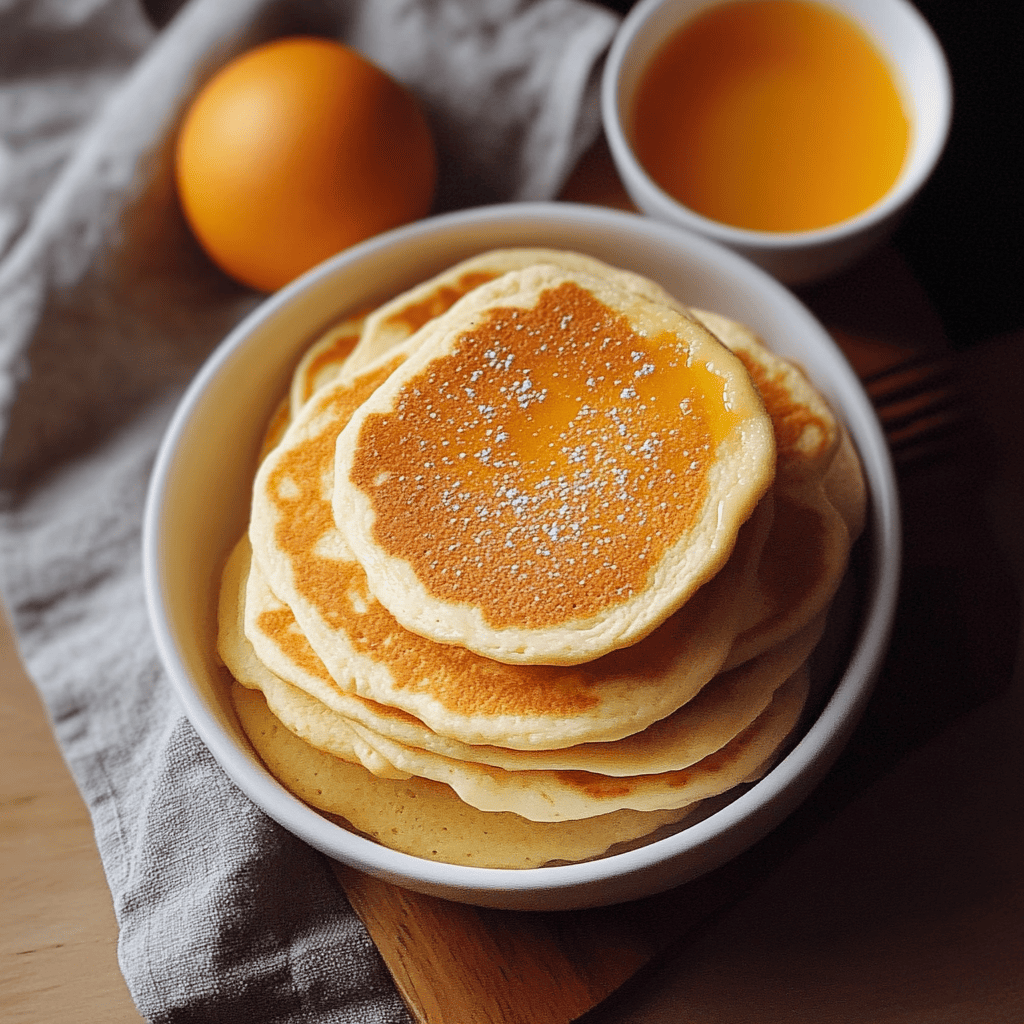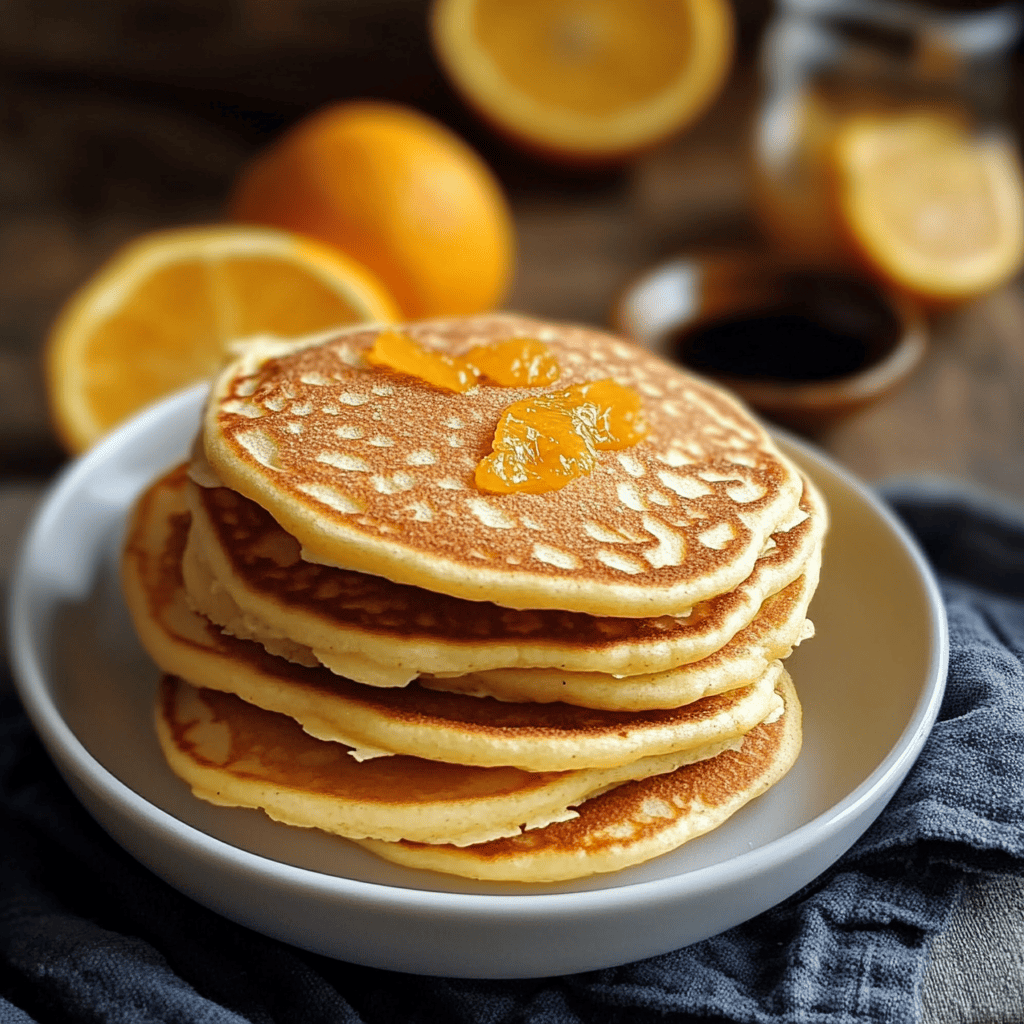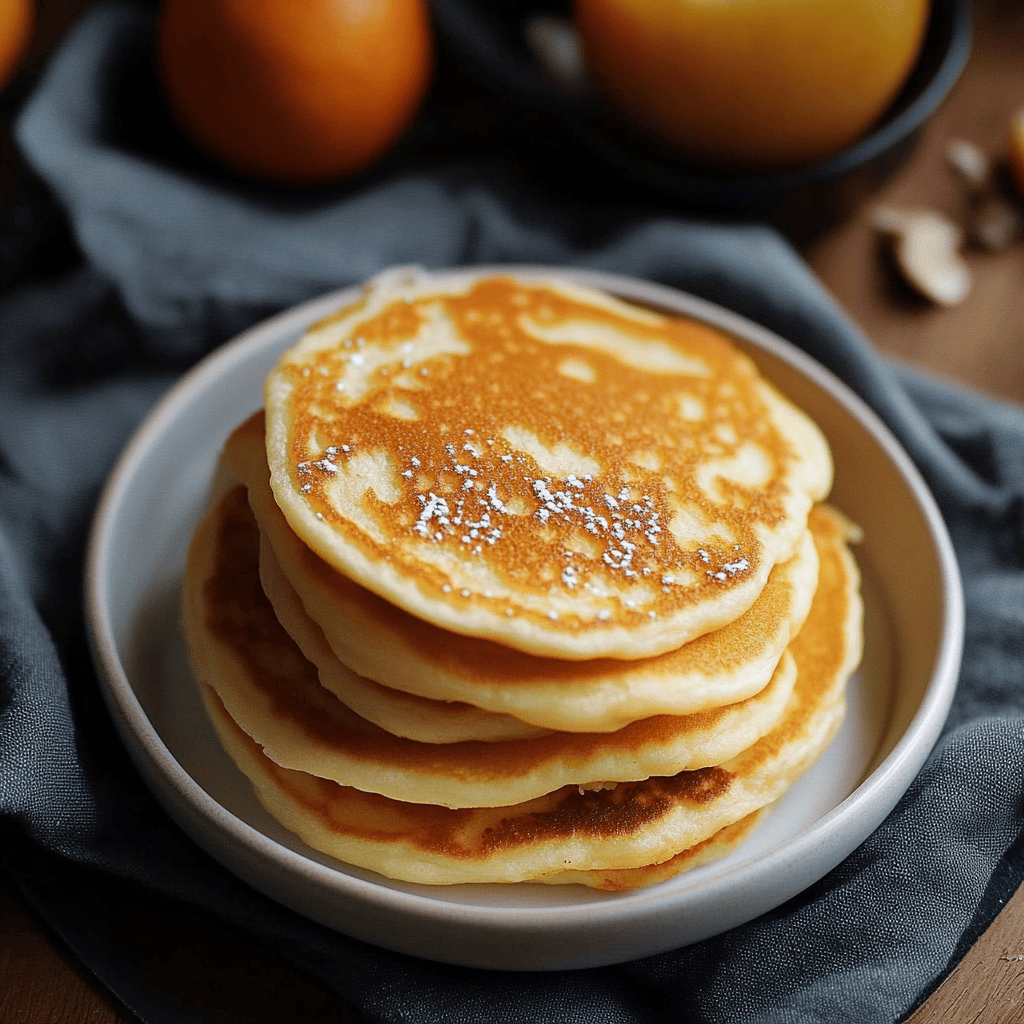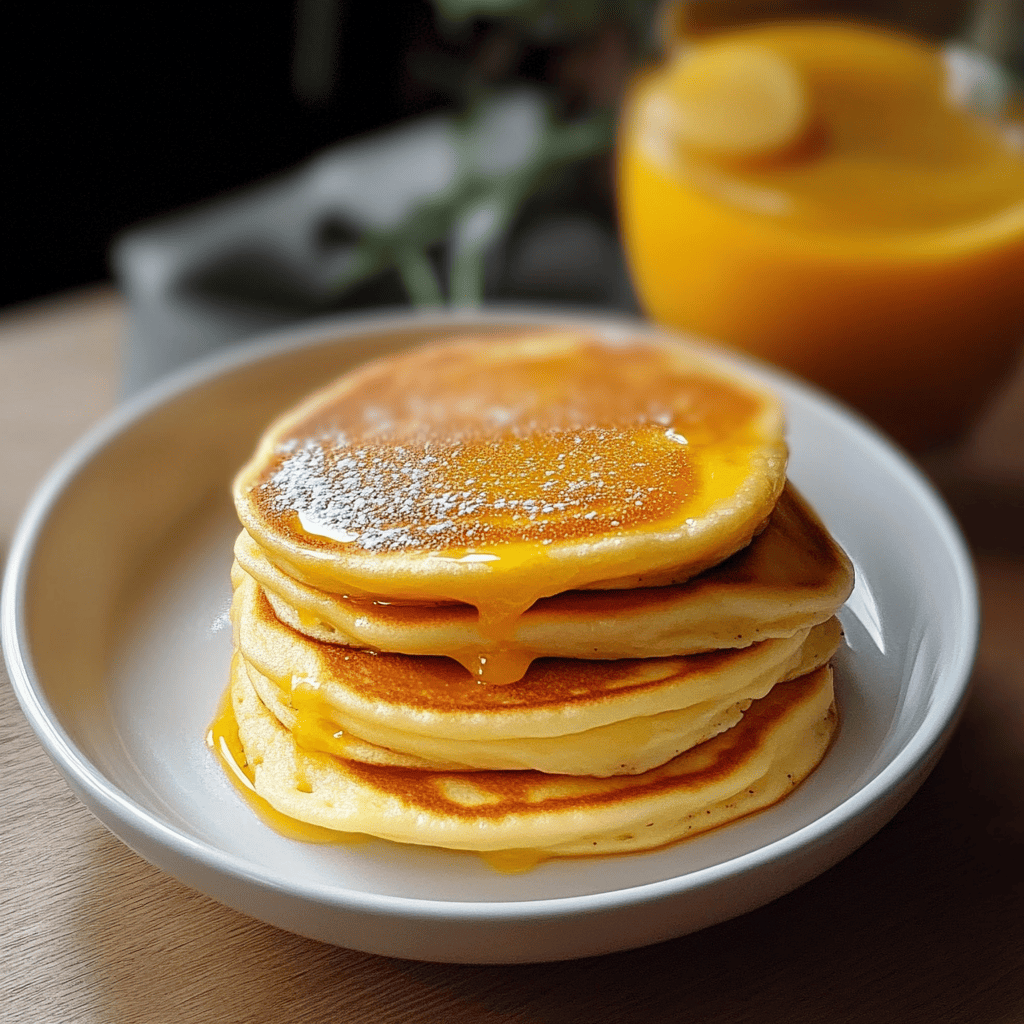Orange and Almond Pancakes with Vanilla Aroma: Fluffy, Fragrant, and Refined Flour-Free
Introduction
Immerse yourself in the pleasure of a healthy and delicious breakfast or snack with these wonderful Orange and Almond Pancakes. Forget refined flours and discover a delicious, fluffy, and flavorful alternative. Each bite will transport you to a citrus garden, with the natural sweetness of almonds and the aromatic touch of vanilla, creating a symphony of sensations that will delight your palate. Ideal for starting your day with energy, as a mid-afternoon treat, or even as a light dessert, these pancakes are proof that healthy food can be incredibly delicious. Plus, their simplicity of preparation makes them the perfect choice for any cook, from the beginner to the most experienced.
Detailed History: The Evolution of the Healthy Pancake
Pancakes, in their various forms, have been a staple in the human diet for millennia. From early “flatbreads” made with ground grains and water cooked over hot stones, to modern fluffy creations, pancakes have evolved to adapt to cultures and available ingredients. In ancient times, they were an efficient way to utilize grains and were found in the diets of diverse civilizations, from the ancient Egyptians to the Greeks and Romans.
With the arrival of the New World, ingredients like corn and maple syrup transformed pancakes in North America, where they became an iconic breakfast. However, as industrialization progressed, refined flours became predominant, stripping many pancakes of their original nutrients.
The search for healthier alternatives began to gain momentum in the 20th century, driven by increased nutritional knowledge and a desire to return to more whole foods. This is where the “healthy pancake” comes in. Beginning in the 1970s and with the rise of natural food awareness, chefs and nutritionists began experimenting with non-traditional flours, such as oat flour, whole wheat flour, and, more recently, nut flours.
More Details on the History and Philosophy of the “Orange and Almond Pancake”
The combination of orange and almond is a classic in Mediterranean and Middle Eastern pastries. In Morocco, for example, almond and orange blossom sweets are very popular. In Spain and Italy, almonds are a staple ingredient in many desserts, and orange, due to its abundance in these regions, is often incorporated to add freshness and a citrus touch. Vanilla, although native to Mexico, has become part of global baking for its warm and comforting aroma.
The creation of the “Vanilla-Scented Orange and Almond Pancake” is a reflection of several contemporary culinary trends:
- Gluten-Free and Low-Carb Cooking: Using coconut flour and almond flour responds to the growing demand for gluten-free and lower-glycemic options. Almond flour is rich in healthy fats and protein, while coconut flour is high in fiber and absorbs a lot of moisture, which contributes to fluffiness.
- Natural Sweeteners: Choosing crushed dates or honey as sweeteners aligns with the preference for natural, less processed alternatives to refined sugar, providing not only sweetness but also nutrients.
- Plant Milks: The inclusion of plant milk (oat, almond or coconut) demonstrates the adaptability of the recipe to vegan diets (if the egg is replaced) and to those seeking to reduce their consumption of dairy products of animal origin.
- Focus on Natural Flavor: By relying on orange juice and zest, along with vanilla extract, the inherent flavor of the ingredients is prioritized, rather than relying on artificial flavors.
This recipe isn’t just a pancake; it’s a statement of purpose. It represents a cuisine that values nutrition without sacrificing pleasure, that explores new textures, and that harnesses the wisdom of natural ingredients to create dishes that are good for both body and soul. It’s a testament to how culinary innovation can take traditional elements and reimagine them to meet the needs and tastes of modern life, while remaining deeply rooted in classic, comforting flavors.

Ingredients
- 100 g of coconut flour
- 100 g of almond flour
- 60 ml of vegetable milk (oat, almond or coconut, to taste)
- 1 large egg
- 30 ml of natural orange juice (freshly squeezed, if possible)
- 1 tsp orange zest (about 1 large orange)
- 1/2 tsp vanilla extract (optional, but highly recommended to enhance the aroma)
- 20 g of crushed dates or 1 tbsp of honey (or maple syrup, agave nectar)
- Coconut or olive oil for cooking the pancakes
Detailed Preparation
- Prepare the Dry Ingredients: In a large bowl, combine the coconut flour and almond flour. Use a hand mixer to mix both flours well, making sure there are no lumps and that they are fully combined. This is important, as coconut flour tends to absorb a lot of moisture.
- Prepare the Wet Ingredients: In another medium bowl, beat the large egg until lightly foamy. Add the plant-based milk (oat, almond, or coconut), freshly squeezed orange juice, and orange zest. If using vanilla extract, add it at this point. Stir in the mashed dates or honey (or liquid sweetener of your choice). Mix all the wet ingredients until well combined and the sweetener is as dissolved or dispersed as possible.
- Combine Ingredients: Gradually pour the wet ingredient mixture over the dry ingredients in the large bowl. Using a spatula or wooden spoon, begin to gently mix. It’s crucial not to overmix the batter; just mix until the dry ingredients are moistened and the batter forms. The batter will be quite thick due to the coconut flour, but don’t worry, this is normal.
- Let the Dough Rest: Once the dough is formed, let it rest at room temperature for at least 5-10 minutes. This step is critical, especially with coconut flour, as it needs time to absorb the liquid and thicken the dough. If the dough seems too thick after resting, you can add an extra tablespoon of plant-based milk until you reach the desired consistency (it should be thick but malleable).
- Heat the Pan: Heat a nonstick skillet or griddle over medium-low heat. It’s important not to set the heat too high so the pancakes cook evenly on the inside without burning on the outside. Lightly grease the pan with a little coconut or olive oil. You can use a pastry brush to spread the oil evenly.
- Cooking the Pancakes: Pour approximately 2-3 tablespoons of batter per pancake into the hot pan. Given the thickness of the batter, you may need to gently spread it with the back of the spoon to form uniform discs about 8-10 cm in diameter. Cook each pancake for 3-4 minutes per side, or until the edges look firm and dry, and small bubbles appear on the surface.
- Flip and Cook the Second Side: Using a wide spatula, carefully flip the pancakes. Cook for an additional 2-3 minutes on the other side, or until golden brown and cooked through in the center. If the pancakes brown too quickly, reduce the heat slightly.
- Serving: Remove the cooked pancakes from the pan and place them on a plate. If you’re making multiple batches, you can keep the pancakes warm in a preheated oven (approximately 70-80°C). Serve immediately with your favorite sides.
Estimated Preparation Time
- Active preparation time: 10 minutes
- Dough resting time: 5-10 minutes
- Cooking time: 15-20 minutes (for about 8-10 pancakes, cooking in batches)
- Estimated total time: 30-40 minutes
Additional Tips
- Don’t Overmix: This is the most important tip for pancakes. Mix only until the dry ingredients are incorporated. Overmixing can develop gluten (although with gluten-free flours the effect is different; it can make the texture less fluffy).
- Batter Consistency: The batter for these pancakes will be thicker than traditional pancakes. This is normal due to the coconut flour. If it’s too thick to spread, add plant-based milk a tablespoon at a time. If it’s too runny (which is rare with these flours), add a little more coconut flour (half a teaspoon at a time).
- Pancake Size: To make flipping easier and ensure even cooking, make medium-sized pancakes (about 8-10 cm in diameter). Very large pancakes can be difficult to handle.
- Enough Oil: Make sure your pan is lightly greased for each batch of pancakes, this will prevent them from sticking and give them a nice golden color.
- Freezing: These pancakes can be frozen once cooked and cooled. Place parchment paper between each pancake and store them in an airtight bag or container. To reheat, you can use a toaster, microwave, or frying pan.
- Flavor Variations:
- Spices: Add a pinch of cinnamon, nutmeg, or cardamom to the dough for a spicy touch.
- Chocolate: Add some unsweetened dark chocolate chips or cocoa nibs to the batter.
- Red Berries: Add fresh blueberries or raspberries to the batter before baking, or serve them as a topping.
- Garnish and Toppings: Serve with fresh fruit (blueberries, orange slices, strawberries), a drizzle of pure maple syrup, honey, Greek yogurt or coconut cream, and a little more orange zest for an extra touch of color and aroma.
- Make the Most of the Orange: You can use the rest of the orange to squeeze more juice and serve it with the pancakes, or to create a little homemade orange marmalade.

Frequently Asked Questions
- Can I substitute coconut or almond flour? The recipe is specifically formulated for these flours due to their unique properties. Replacing them with other gluten-free flours (such as rice, oat, etc.) would require drastically adjusting the proportions of liquids and other ingredients, and the final texture would be very different. Substitution is not recommended.
- Can I make them vegan? Yes, to make them vegan, replace the large egg with a “flax egg” (1 tablespoon of ground flax mixed with 3 tablespoons of water, let sit for 5 minutes) or a commercial egg substitute. Make sure the plant-based milk and sweetener are also vegan (maple or agave syrup instead of honey).
- Why are my pancakes dry or crumbly? This may be because the coconut flour absorbs too much moisture. Make sure the batter isn’t too thick before cooking; if it is, add a little more plant-based milk, spoonful by spoonful, until it reaches a more manageable consistency. It’s also important not to overcook them.
- Can I use bottled orange juice? Yes, you can, but freshly squeezed orange juice will always offer a more vibrant and fresh flavor and aroma, which is key for this recipe.
- How sweet are these pancakes? Add 20g of dates or 1 tbsp of honey for a mild, natural sweetness. If you prefer more sweetness, you can add a little more sweetener to the batter or serve with more honey/syrup.
Texture and Flavor
These pancakes are a delight in terms of texture and flavor .
- Texture: They’re surprisingly fluffy and soft on the inside, despite not containing refined flours. The coconut flour provides an almost ethereal lightness and great absorbency, while the almond flour contributes a delicate moisture and a light bite . The edges are perfectly browned, offering a slight crunch that contrasts with the softness inside. They’re not chewy or heavy, but melt in your mouth.
- Flavor: The flavor profile is fresh, bright, and comforting . The orange takes center stage , with its vibrant citrus flavor from the juice and zest, which adds floral notes and a touch of tangy sweetness. The almond flour contributes a soft, slightly sweet, nutty flavor that beautifully complements the orange. Vanilla extract (if using) adds a layer of warmth and aroma that elevates the whole thing, making the pancakes even more inviting. The natural sweetener (dates or honey) provides a balanced, non-overpowering sweetness , allowing the orange and almond flavors to shine through. Overall, it’s a clean, natural, and deliciously aromatic flavor .
Consumer Context
- Energizing and Healthy Breakfast: Perfect for starting the day with a nutritious and delicious meal, especially if you’re looking for a gluten-free and low-carb option.
- Capricious Snack: An ideal mid-afternoon snack that will satisfy you without feeling heavy, combining flavor and nutrition.
- Special Brunch: Impress your guests with a healthy and gourmet alternative to traditional pancakes. You can pair them with yogurt, fruit, and other healthy toppings .
- Light Dessert: Served with fresh fruit and a touch of syrup, they can make a light and satisfying dessert.
- Food on the Go: Once cooled, they’re easy to pack for lunch or a snack at the office, school, or a picnic.
Visual Aspect
The “Orange and Almond Pancakes with Vanilla Aroma” are visually very attractive and evoke a feeling of freshness and naturalness.
- Color: They have a beautiful light to medium golden hue on the surface, with subtle darker flecks where the coconut flour has been lightly toasted. Tiny orange dots from the orange zest are visible in the dough, adding a touch of color and promising the citrus flavor.
- Shape and Volume: They’re fluffy and have a good volume , rising slightly during baking, reflecting their lightness. They’re generally round, although because they’re a denser dough, they can have slightly more rustic and organic edges, giving them a homemade charm.
- Surface Texture: The cooked surface may have a slightly porous and smooth appearance , inviting absorption of syrup or any topping .
- Garnishes: When served, fresh toppings (such as thin orange slices, colorful berries, or a dusting of powdered sugar) enhance the visual appeal, creating a vibrant contrast and an invitation to enjoy.
Curiosities
- Coconut Flour: This is a byproduct of coconut milk. It’s obtained from the dried pulp of the coconut after extracting the oil and milk. It’s remarkably high in fiber (more than any other flour), which makes it highly absorbent and contributes to satiety. Therefore, much less is needed than other flours.
- Almond Flour: Produced by grinding blanched (skinned) almonds. It’s an excellent source of vitamin E, magnesium, and healthy fats, making it nutritious and giving baked goods a tender texture.
- Citrus Power: Orange zest, unlike juice, contains volatile essential oils that are responsible for most of the fruit’s intense, fresh aroma. Therefore, a little zest has a big impact on the flavor.
- Dates as a Sweetener: Dates are a natural sweetener that not only provide sweetness, but also fiber, potassium, and other minerals, making them a more nutritious option than refined sugar.
- Vanilla: Black Gold: Vanilla is the second most expensive spice in the world (after saffron) due to its complex cultivation and curing process. Its warm, sweet aroma is universally appreciated in baking.
Nutritional Value (estimated per serving)
- Note: Nutritional value is an estimate and may vary depending on the exact size of the pancakes, the type of plant-based milk, the amount of sweetener, and the oil used for cooking. This estimate is based on approximately 8-10 medium-sized pancakes (approximately 2 pancakes per serving).
- Serving Suggestion: 2 medium pancakes
- Calories: 250-300 kcal
- Protein: 8-12g
- Total Fat: 18-25g (mainly healthy fats from almonds and coconut)
- Saturated Fat: 5-8g (from coconut flour and coconut oil)
- Carbohydrates: 15-20g
- Fiber: 7-10g (very high due to coconut flour)
- Sugars: 5-10g (natural from the orange and sweetener)
- Sodium: 50-80mg (low, no added salt)
Additional Benefits and Interesting Facts
- Gluten Free: Ideal for people with gluten sensitivity or celiac disease.
- Rich in Fiber: Coconut flour is exceptionally rich in fiber, which contributes to digestive health, helps maintain satiety, and stabilizes blood sugar levels.
- Source of Healthy Fats: Almond flour and coconut oil provide monounsaturated fats and medium-chain triglycerides (MCTs), which are beneficial for cardiovascular health and energy.
- Plant Proteins: Almonds are a good source of plant protein, which enhances the nutritional profile of the pancakes.
- Vitamins and Minerals: Almonds provide vitamin E and magnesium. Oranges are rich in vitamin C.
- Low Glycemic Index: By using nut flours and natural sweeteners, these pancakes have a lower impact on blood sugar levels compared to traditional white flour pancakes.
- Versatility: They can be adapted to different diets (vegan, keto if sweeteners are adjusted, etc.) with small modifications.
Other Information
- Allergens: Contains nuts (almonds, coconut) and egg. If you have allergies, please be aware.
- Storage: Cooked pancakes can be stored in an airtight container in the refrigerator for up to 3-4 days.
- Children’s Food: These are an excellent option to include in children’s diets, as they are nutritious and have a pleasant, sweet flavor without excess sugar.
- Environmental Impact: Coconut flour is a byproduct, making it a relatively sustainable option.

Conclusion
Orange and Almond Vanilla-Scented Pancakes are a true culinary revelation. They prove that healthy food doesn’t have to be boring or bland; on the contrary, it can be a complete sensorial experience, rich in textures, flavors, and aromas. This recipe is a testament to the versatility of natural ingredients and how, with a little creativity, we can transform a classic dish into a nutritious and delicious option. We invite you to make these pancakes, enjoy their fluffiness without refined flours, and let yourself be enveloped by the fragrance of orange and vanilla. They are perfect for any time of day, giving you energy and well-being with every bite. Go ahead and try them and elevate your healthy culinary experience!

